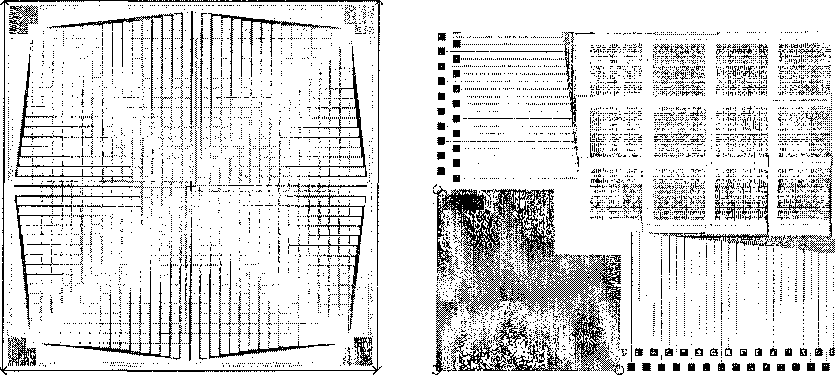49

(a) Second-generation terahertz SLM
(b) SLM fabrication mask (zoom-in view)
Figure 5.5 : (a) The second-generation terahertz SLM is a 32×32 array of individual
pixels in Figure 5.6(a). Each pixel is independently controlled by an external voltage
between the respective Schottky electric pad and the ohmic contacts (L-shaped pads
at the four corners). The 256 Schottky pads on each side control all the pixels in one
quadrant (triangular-shaped). (b) The active area of each pixel is 880 μm×860 μm
and the spacing between pixels is about 200 μm. The connecting wires between the
pixels are 6 μm in width and 4 μm apart.
voltage. Chen et al. demonstrate a 55% modulation depth in amplitude transmission
at a 16V bias on a terahertz modulator based on this SRR design [12].
5.5 Characterization experiments and results
Characterization of the two identical second-generation THz SLM samples (SLM 1
and SLM 2) uses a terahertz time-domain spectroscopy system with fiber-coupled
photoconductive antennae for both terahertz generation and detection. A control
circuit system synchronizes the THz SLM with the terahertz measurement system
(see Appendix B). Figure 5.7 (a) and (b) show the terahertz amplitude transmission
More intriguing information
1. The name is absent2. Word searches: on the use of verbal and non-verbal resources during classroom talk
3. The name is absent
4. THE ECONOMICS OF COMPETITION IN HEALTH INSURANCE- THE IRISH CASE STUDY.
5. Fiscal federalism and Fiscal Autonomy: Lessons for the UK from other Industrialised Countries
6. The name is absent
7. FOREIGN AGRICULTURAL SERVICE PROGRAMS AND FOREIGN RELATIONS
8. Fiscal Rules, Fiscal Institutions, and Fiscal Performance
9. THE INTERNATIONAL OUTLOOK FOR U.S. TOBACCO
10. The name is absent